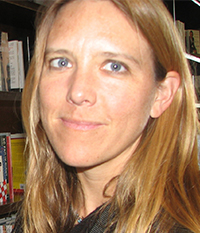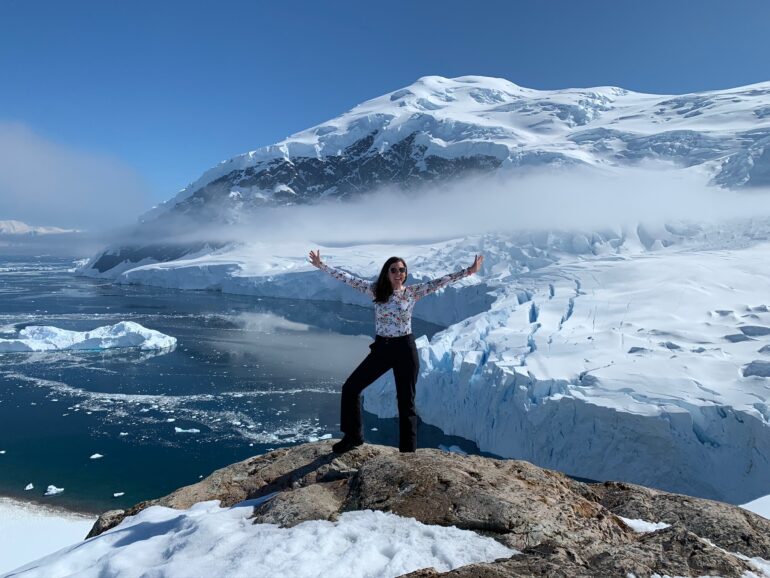Conservation scientist Dr. Krissa Skogen specializes in the pollination biology of evening primrose flowers that grow in the American West. But in December her work took her to a starkly different location: she was among the largest-ever all-women delegation to Antarctica, traveling with 99 other women in STEMM (science, technology, engineering, math and medical) fields to the frozen continent as part of a program called Homeward Bound meant to build women’s leadership in the fight for a more sustainable planet. Skogen, PhD, who works at the Negaunee Institute for Plant Conservation Science and Action at the Chicago Botanic Garden and is an adjunct assistant professor at Northwestern University, is also passionate about empowering young women and girls to become scientists.
What was it like to be in Antarctica, and how did it impact your view of the natural world and our impact on it?
The scale and simplicity provide such a striking contrast to everyday life. You’re looking at water, sky, ice and snow, and maybe some rocks and mountains poking out. I found it to be very calming, and also really humbling: so vast, so simple, so beautiful.
You feel so small and so insignificant, and realize how little you matter in the context of everything else. Right now there are still penguins there, icebergs are still moving, I’m not there to see it but it is still happening. Despite feeling small and insignificant, I realize that the things I and others do every single day can have a huge impact both for better or for worse, on people and places including this magical place that is so far away. We can make changes in our day-to-day lives that can slow climate change, we can work with organizations to create a better future for ourselves and others. We have agency and we can make a difference – I returned from Antarctica with a renewed sense of purpose and a perspective that I wouldn’t have without having gone.

What did you think of the recent news about record high temperatures in Antarctica — reaching 70 degrees?
You see these headlines and you feel totally helpless, this wave of panic. I felt this deep heartache, that there’s this place that changed me and terrible things are happening to it, yet I’m far away and it feels out of my control. It almost feels like when you hear about a tragedy happening to someone you care for deeply or who had an important impact on your life, like a mentor or teacher who provided you with transformational guidance. There’s this feeling of loss, knowing without that person you wouldn’t be who you are.
How has the pandemic affected your research?
The pandemic has cancelled travel, which impacts my research as I usually do fieldwork studying plants and pollinators out west in the spring and summer. My work has shifted more to revising manuscripts and digging into datasets, which has been good, just different than what I’d normally be doing this time of year. The lovely result is that I’ve been working more closely with former students, which is always fun, and has been a great reminder of how lucky I have been to work with such great people, and that the people you work with are just as important as the work you do.
In keeping with the theme of Homeward Bound, do you think more women’s leadership is needed to address climate change and increase sustainability?
The large, pressing challenges we face in society — climate change, things like coronavirus — aren’t the kind we’ve ever faced before, so they will require creative thinking on a scale we can’t even imagine or anticipate. There’s absolutely no evidence that the people who have historically engaged in the scientific pursuit are any more talented or better equipped to tackle these problems than those who have been excluded. Greater diversity of experiences brings diversity of insight and perspective, and different ways of solving problems. Arriving at the solutions we need to the big problems we face will require more and different people at the table – women and minorities have historically been underrepresented in STEMM fields. There are many barriers to making science more diverse and equitable, including opportunities for education and experience that compel talented people to pursue a career in science, and then the additional challenges with retaining and supporting talent once they are in STEMM careers. Programs like Homeward Bound equip us with the tools, skillset and supportive network to effect the change that is needed, including lowering and eliminating the barriers that limit who decides to participate and stay working in STEMM fields.
Have you had women mentors in your career?
My career in STEMM has entirely been facilitated by supportive mentors – women and men. Without these relationships, I’m confident I wouldn’t be where I am today.
The woman who taught one of my first-year classes in college, Dr. Cindy Johnson, was very supportive and encouraging, so I had a really great undergraduate research experience. She encouraged me to present our research at national meetings, to get the funding to be able to go. That was huge, I didn’t know these things existed. My parents did not graduate from college. I’ve had extremely supportive mentors all along the way, they’ve made time for me, they’ve provided me with guidance, challenged me in ways I didn’t realize I wasn’t challenging myself. While most of my mentors have been women, I’ve been very lucky to have supportive male mentors as well, and I know this isn’t always the case. When I started my job and began mentoring students myself, I recognized that I now had the opportunity and responsibility to help people coming up behind me. This is something that I really value and take seriously. Having supportive mentors who’ve been interested and invested in my success has been key to all I’ve accomplished.
What interests you about studying the evening primrose? What can it tell us about our changing planet?
My research focuses on plant pollinator interactions. I’m a botanist at heart, so I’m interested in how plants mate. I study this one group of flowering plants that have flowers that open at dusk – the evening primroses. They’re evolved to be pollinated primarily by organisms active at night, so they have big flowers, they’re light in color, a good contrast against the dark at night. And they usually have a long tube and the flowers are highly fragrant — like jasmine. They are pollinated by hawkmoths, which are active at night; the moths have a hollow tongue that they stick into the flower like a straw and drink the nectar out.
In the process, these moths will get pollen on their body and face and fly to the next flower; they might bump into the stigma, the female part of flower, and drop off some pollen. And these big-bodied moths can fly really far, moving pollen much farther across the landscape. While I don’t study climate change explicitly, there will be consequences of climate change for these native plant species and for pollinators in general, as many studies continue to reveal. The work I do informs this larger understanding of how plants and pollinators interact, which can and will be altered by changes in precipitation and temperature in the places where they occur.
Do you see parallels between your work on the evening primrose and your experience in Antarctica?
I go where these plants naturally occur, sometimes it’s an amazing beautiful place or sometimes it’s an area that requires a closer connection, something like an oil and gas field, that’s not beautiful unless you spend the time getting to know the plants and creatures that still can live in those landscapes. You see these places and you experience them and they leave an impact on you, you take it with you in your work and personal life. We live a mile from Lake Michigan; I walk over and just stare and look at the lake. It provides that simplicity — like a glimpse back to Antarctica: just the sky, just water. I can be very far from the amazing places I’ve been and summon a similar feeling. It’s refreshing and restoring.

Regarding the work you do with youth, is connecting with nature or advocating for the environment more important than ever now given what we are going through with the pandemic?
Yes, definitely. Today’s youth is far more connected to each other and the world overall. I suspect that, just like climate change, they will be impacted by the changes resulting from COVID19 for far longer than older generations, for better and worse. The environmental benefits of stay at home orders include reduced smog and improved water quality. If you live in an area like Los Angeles and are seeing the mountains for the first time, that is likely to leave an impact. In addition, because so many things are closed or have been cancelled, a lot of people are spending time in nature that never really did before. I suspect that these experiences will impact our youth in ways that will transform the future, many of them will remember how things were before. I am hopeful that these positive outcomes will inspire youth to become more engaged and advocate for the environment in the future.
More from Better:
- Black Lives Matter: 5 Ways to Help in Chicago Right Now
- Local Author Jeanne Bishop Finds Grace Through Writing About a Senseless Family Tragedy
- New Phase of Openings Brings New Phase of Fear: How To Cope
 Kari Lydersen is a Chicago-based journalist, professor, and author who specializes in topics including energy, environment, labor, and housing. She leads the Social Justice & Investigative specialization in the journalism graduate program at Northwestern University, and she has written for outlets including The Washington Post, The New York Times, The Guardian and Huffington Post. She is the author of five books.
Kari Lydersen is a Chicago-based journalist, professor, and author who specializes in topics including energy, environment, labor, and housing. She leads the Social Justice & Investigative specialization in the journalism graduate program at Northwestern University, and she has written for outlets including The Washington Post, The New York Times, The Guardian and Huffington Post. She is the author of five books.

